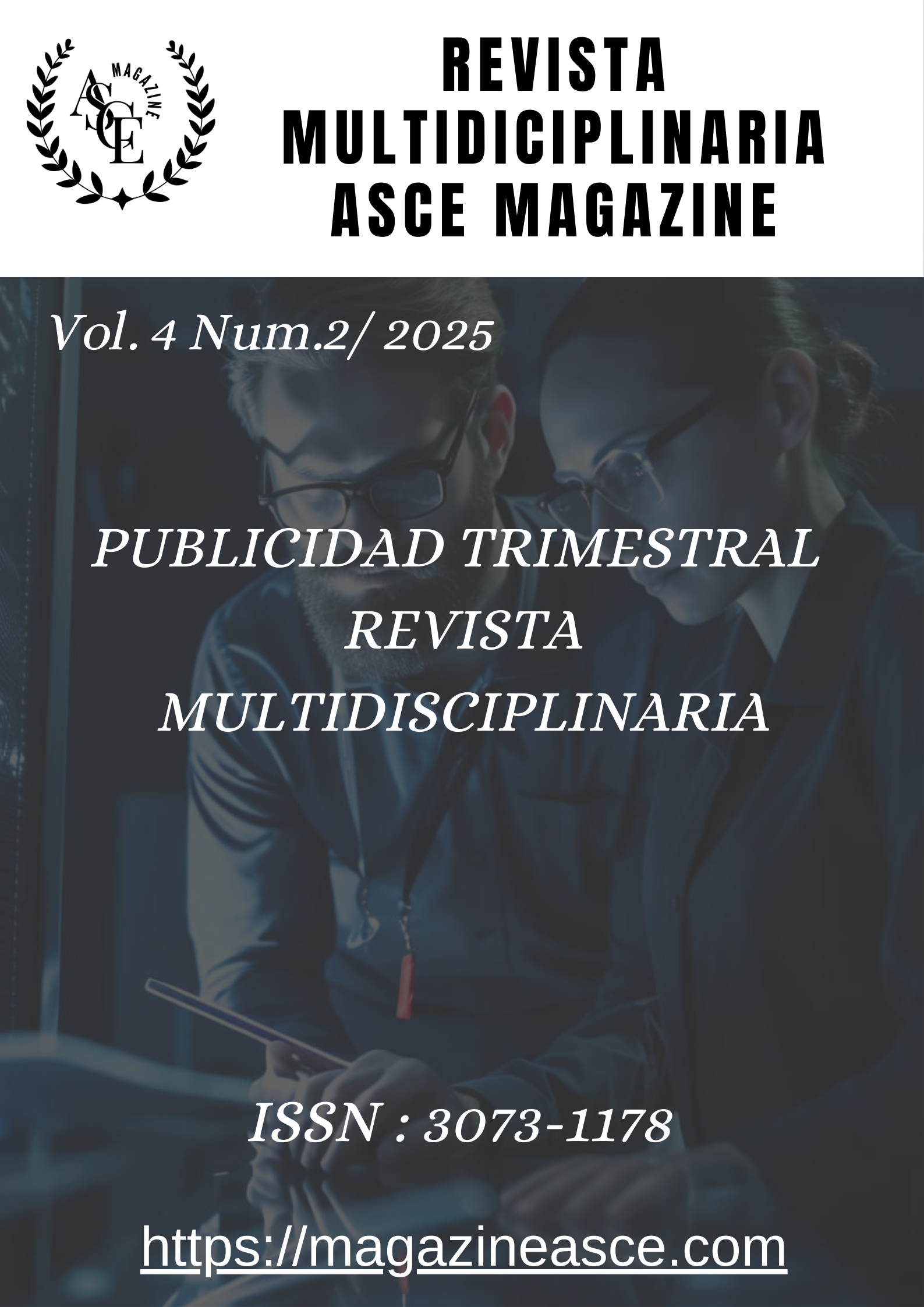The Social Work Approach to Digital Violence in Intimate Partner Relationships
DOI:
https://doi.org/10.70577/ASCE/1225.1253/2025Keywords:
igital violence, Social Work, Affective relationships, Interdisciplinary approach, PreventionAbstract
This study analyzes the Social Work approach to digital violence in romantic couples in the Central Sierra region of Ecuador. Currently, the digitalization of affective relationships has given rise to new forms of control, surveillance and coercion exercised through technological means, which representsan emerging challenge for the social sciences. Regarding the methodology, a quantitative, cross-sectional and descriptive-analytical design was applied, using an adapted version of the Digital Violence Questionnaire (DVQ) to a random sample of 1,000 people of legal age with experience in romantic relationships. The results showed a high prevalence of digital violence: 88.3% of the participants reported at least one form of victimization, and 49.6% presented multiple victimization (five or more types of digital violence). Bidirectional patterns of violence were identified, with significant differences according to gender and age. The results show the need to make digital violence visible as a structured and widespread problem in couple relationships, proposing specific recommendations to strengthen the practice of Social Work in digital contexts, such as designing differentiated intervention strategies that include prevention, comprehensive care and restitution of rights, considering the complexity of the phenomenon and the intersectional particularities
Downloads
References
Amadori, A., & Brighi, A. (2025). Technology facilitated sexual violence among sexual and gender minority youth: The moderating role of digital resilience. Computers in Human Behavior, 166. https://doi.org/10.1016/j.chb.2025.108576 DOI: https://doi.org/10.1016/j.chb.2025.108576
Borrajo et al. (2015). The development and validation of the cyber dating abuse questionnaire among young couples. Computers in Human Behavior, 48, 358-365. https://doi.org/10.1016/j.chb.2015.01.063 DOI: https://doi.org/10.1016/j.chb.2015.01.063
Cano, O. L., Guzmán, R., Baena, E. S., Pontigo, P., & Castro, J. (2024). El modelo ecológico de Bronfenbrenner-Morris como marco teórico explicativo. Boletín Científico de la Escuela Superior Atotonilco De Tula, 11(22), 36–38. https://doi.org/10.29057/esat.v11i22.12094 DOI: https://doi.org/10.29057/esat.v11i22.12094
Castillo, M. y Terán, G. (2023). Violencia “online” en el noviazgo en estudiantes universitarios ecuatorianos. Revista Anatomía Digital. Vol. 6. https://doi.org/10.33262/anatomiadigital.v6i4.3.2790 DOI: https://doi.org/10.33262/anatomiadigital.v6i4.3.2790
Creswell, J. W., & Creswell, J. D. (2021). Investigación cualitativa, cuantitativa y mixta. Pearson Educación.
Euan, A. J., y Pinto, M. F. (2022). Variables asociadas a la violencia digital de pareja en una muestra de adultos jóvenes de Yucatán, México, entre el 2015 y 2020. Revista Logos Ciencia & Tecnología, 14(3), 73–85. https://doi.org/10.22335/rlct.v14i3.1609 DOI: https://doi.org/10.22335/rlct.v14i3.1609
Flynn, A., y Mathias, J. (2023). Reimagining ecological systems theory for the digital era: Lessons for social work. Australian Social Work, 76(2), 117–129. https://doi.org/10.1080/0312407X.2022.2100933
Marcum, C., & Choi, K.-S. (2024). Editorial: Cyberviolence: A plague of victimization and exploitation online. Journal of Aggression, Conflict and Peace Research, 16(4), 281–283. https://doi.org/10.1108/JACPR-10-2024-942 DOI: https://doi.org/10.1108/JACPR-10-2024-942
Martínez Gómez, J. A., Bolívar Suárez, Y., Yánez Peñuñuri, L. Y., & Gaviria Gómez, A. M. (2021). Validación del Cuestionario de Violencia entre Novios (DVQ R) para víctimas en jóvenes adultos colombianos y mexicanos. RELIEVE – Revista Electrónica de Investigación y Evaluación Educativa, 27(2), artículo 1. https://doi.org/10.30827/relieve.v27i2.21963 DOI: https://doi.org/10.30827/relieve.v27i2.21963
Montero Fernández, D., García Rojas, A. D., Hernando Gómez, A., & Del Río Olvera, F. J. (2022). Validación del Cuestionario de Violencia Digital (Digital Violence Questionnaire, DVQ) en la pareja sentimental. RELIEVE – Revista Electrónica de Investigación y Evaluación Educativa, 28(2), artículo 3. https://doi.org/10.30827/relieve.v28i2.26142 DOI: https://doi.org/10.30827/relieve.v28i2.26142
Otzen, T., y Manterola, C. (2017). Técnicas de muestreo sobre una población a estudio. International Journal of Morpshology, 35(1), 227-232. https://doi.org/10.4067/S0717-95022017000100037 DOI: https://doi.org/10.4067/S0717-95022017000100037
Reyes et al. (2022). La ciberviolencia en parejas jóvenes y factores predictores. Revista Behavioral Psychology / Psicología Conductual. Vol. 30, Nº 2. https://doi.org/10.51668/bp.8322204n DOI: https://doi.org/10.51668/bp.8322204s
Reyes, V. (2024). Ciberviolencia en parejas adolescentes y jóvenes: prevalencia y diferencias en función del sexo, la edad, el número de parejas y el nivel de estudios. Revista Anuario de Psicología/The UB Journal of Psychology. Vol. 54 Núm. 3. https://doi.org/10.1344/anpsic2024.54.3.2 DOI: https://doi.org/10.1344/anpsic2024.54.3.2
Rodríguez C., Durán, M., & Martínez-Pecino, R. (2020). Ciberviolencia en las relaciones de pareja: Una revisión sobre su metodología de investigación. Anales de Psicología, 36(2), 200-209. https://doi.org/10.6018/analesps.370451 DOI: https://doi.org/10.6018/analesps.370451
Rodríguez-Castro, Y., Martínez-Román, R., & Lameiras-Fernández, M. (2025). The Dark Side of Boys’ Compliments to Girls: Exploring Their Relationship with Sexism and Cyberviolence Towards Intimate Partners. Behavioral Sciences, 15(5), 572. https:// doi.org/10.3390/bs15050572 DOI: https://doi.org/10.3390/bs15050572
Romero, G. (2023) Análisis del modelo ecológico de Bronfenbrenner, su aplicación en la percepción del tiempo dentro del aula. Perspectivas, 8(23), 120-133. https://doi.org/10.26620/uniminuto.perspectivas.8.23.2023.120-133 DOI: https://doi.org/10.26620/uniminuto.perspectivas.8.23.2023.120-133
Ruiz-Pérez, I., Pastor-Moreno, G., & Escribà-Agüir, V. (2021). Violencia en relaciones íntimas mediadas por tecnología: una revisión sistemática. Gaceta Sanitaria, 35(5), 467–474. https://doi.org/10.1016/j.gaceta.2020.05.004 DOI: https://doi.org/10.1016/j.gaceta.2020.04.005
Sánchez Mariño, J. N. (2024). Violencia digital en parejas jóvenes (Trabajo de titulación, Universidad Técnica de Ambato, Facultad de Jurisprudencia y Ciencias Sociales, carrera de Trabajo Social). Repositorio Universidad Técnica de Ambato. https://repositorio.uta.edu.ec/server/api/core/bitstreams/f82e6593-0221-4cd8-84cd-5b23e45d389c/content
Sandoval, M. W., Venegas-Meza, A. J., & Galdames-Paredes, A. M. (2020). Violencia en parejas de jóvenes chilenos: análisis y propuestas desde el Trabajo Social. Trabajo Social Global, 10(18), 116–140. https://doi.org/10.30827/tsg-gsw.v10i18.9345 DOI: https://doi.org/10.30827/tsg-gsw.v10i18.9345
Solar Rodríguez, C. (2025). La relación entre el uso de Instagram, la violencia digital y el ajuste diádico en la pareja [Trabajo de fin de máster, Universidad de Oviedo, Máster en Psicología General Sanitaria]. Repositorio Institucional de la Universidad de Oviedo. https://digibuo.uniovi.es/dspace/bitstream/handle/10651/76343/TFM_CristinaSolarRodriguez.pdf?sequence=4&isAllowed=y
Downloads
Published
How to Cite
Issue
Section
License
Copyright (c) 2025 Jhoselyn Aleida Jacome Peñaherrera, Oliver Mauricio Vivanco Pillo, PhD. Elena Burgaleta Pérez

This work is licensed under a Creative Commons Attribution-NonCommercial-NoDerivatives 4.0 International License.
Eres libre de:
- Compartir : copiar y redistribuir el material en cualquier medio o formato
- Adaptar : remezclar, transformar y desarrollar el material
- El licenciante no puede revocar estas libertades siempre y cuando usted cumpla con los términos de la licencia.
En los siguientes términos:
- Atribución : Debe otorgar el crédito correspondiente , proporcionar un enlace a la licencia e indicar si se realizaron cambios . Puede hacerlo de cualquier manera razonable, pero no de ninguna manera que sugiera que el licenciante lo respalda a usted o a su uso.
- No comercial : no puede utilizar el material con fines comerciales .
- CompartirIgual — Si remezcla, transforma o construye sobre el material, debe distribuir sus contribuciones bajo la misma licencia que el original.
- Sin restricciones adicionales : no puede aplicar términos legales ni medidas tecnológicas que restrinjan legalmente a otros hacer algo que la licencia permite.






































